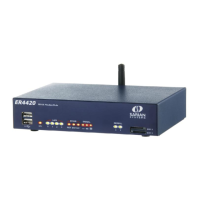General system parameters
Digi TransPort User Guide 624
Miscellaneous configuration items
This section is for those configuration settings that do not fit neatly into any other group of
settings.
Note Depending on the router model, some of these options may not be available.
Use Config n when the router powers up
The router maintains two configuration files, either of which may be invoked on power-up.
Select the required one from the drop-down selection box. Use this option with care as
selecting the incorrect configuration file can cause confusion.
Allow anonymous FTP login
When checked, this checkbox enables the router to accept anonymous logins. The default
state is Off and the security implications of enabling this option should be considered carefully
before applying.
Additional FTP NAT port n
Standard FTP uses two well-known ports, a control port and data port. These are low-number
ports, and may be blocked by firewall rules. As such, it may be that an FTP server may be
listening on a non-standard control port. This parameter is used to specify the port that the
router should monitor for the FTP PORT and PASV commands. These commands contain
information relating to IP addresses and Ports which should be modified during the NAT
process. The NAT modifications may result in different-sized packets being generated that
then require that the TCP sequence numbers be modified to allow for the changes.
SNMP Enterprise number
The value of the OID (Object IDentifier) used by SNMP management tools when accessing the
MIB (Management Information Block). This number must form part of the OID used to access
individual items in the MIB as a prefix.
For example: SNMPv2-SMI::enterprises.16378.10001.
SNMP Enterprise Name
The name corresponding to the above Enterprise Number.
Only resolve DNS request for domain
Entering a domain name here restricts DNS requests to the specified domain only.
W-WAN LED to display W-WAN, ISDN/PSTN
On the front panel of the display of models fitted with a W-WAN module, is an LED that can be
used to display the status of the W-WAN module or the status of the PSTN/ISDN connection.
Use the drop-down selection box to choose what the LED displays. The ISDN/PSTN settings
depend upon which of these two options are available on the router.
Serial LED to display Connection, DTR
On the front panel of the router is an LED dedicated to indicating the status of various signals
on the asynchronous serial line. Use the drop-down selection box to choose which signal
status to display. On modules fitted with W-WAN, this LED has additional functionality, it can
also be used to display the W-WAN signal strength.

